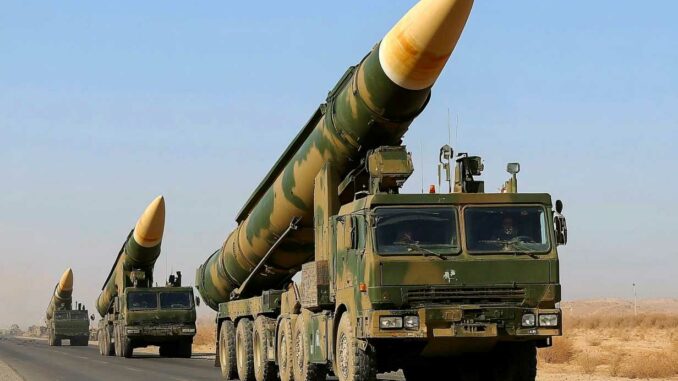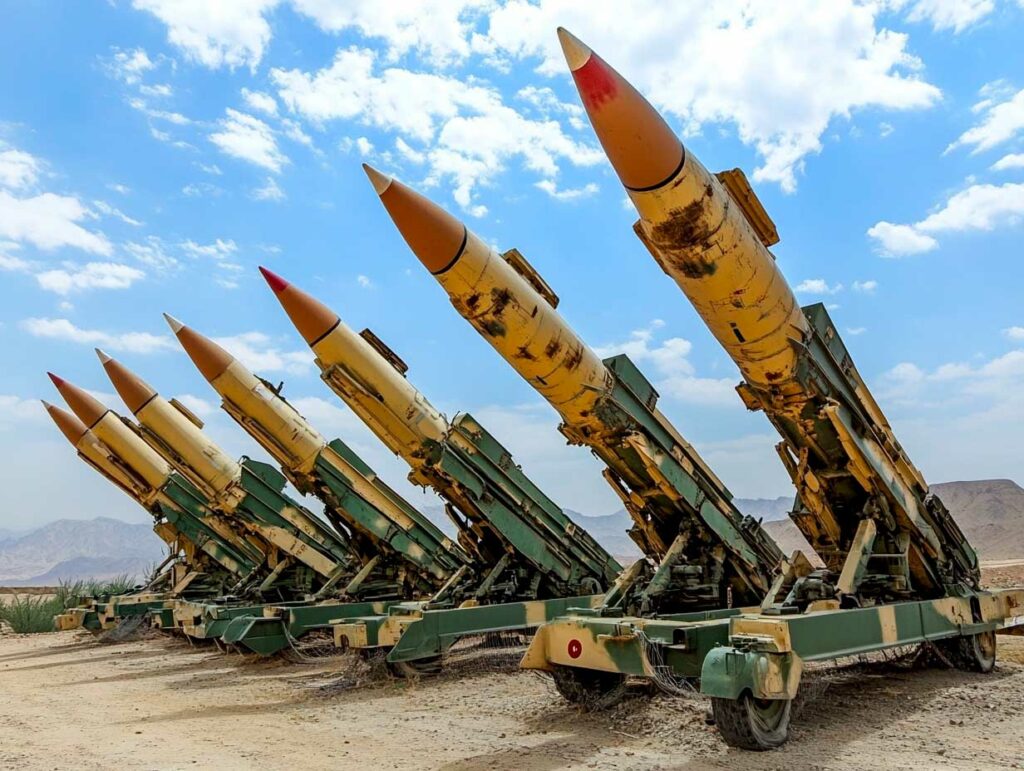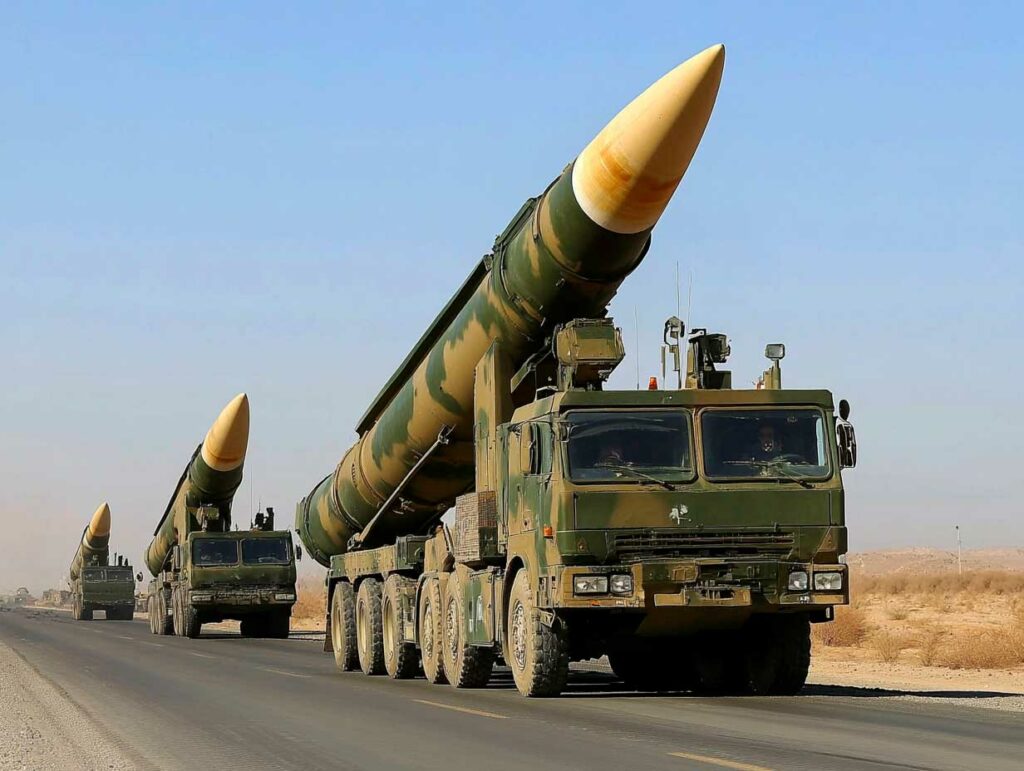
Israel has targeted Iranian missiles, but Tehran still has a large ballistic force. Technical analysis of its arsenal and regional range.
Following Israeli strikes against military and scientific targets in Iran, including missile launch sites and senior officials involved in the ballistic program, the key question is: what remains of Iran’s retaliatory capability? Tehran has a wide range of short- and medium-range ballistic missiles, using liquid and solid propellants, developed through collaboration or locally. The April 2024 attack, during Operation “True Promise,” demonstrated Iran’s ability to combine missiles, drones, and cruise missiles. Despite Israeli strikes, its arsenal remains the main strategic means of striking targets more than 1,000 km away, particularly in Israel.

The strategic range of Iranian ballistic missiles
Iran’s arsenal is mainly based on medium-range ballistic missiles (MRBMs) capable of reaching Israel from Iranian territory. To cover the 1,200 to 1,800 km separating Tehran from Tel Aviv, missiles with a range of over 1,000 km are needed. To date, Iran has around ten compatible models.
Among them, the Ghadr-110, derived from the Shahab-3, is a liquid-fuel missile with a range of 1,600 km, capable of carrying a warhead weighing around 750 kg. Derived from North Korean (No-dong) technology, it remains vulnerable to detection during the launch phase due to its long preparation time.
In contrast, newer systems such as the Kheibar Shekan use solid fuel, which reduces the time between deployment and launch. This missile has an estimated range of 1,450 km, a cruise speed of over Mach 4, and can maneuver in the terminal phase thanks to guidance fins and a satellite navigation system. This combination increases the likelihood of penetration of Israeli missile defenses such as the Iron Dome or Arrow-3.
In 2023, Iran also announced the development of the Fattah, described as a hypersonic missile, and therefore non-ballistic. Although its operational status is uncertain, Tehran claims that it can reach Mach 13 to Mach 15 over distances of 1,400 km and perform atmospheric maneuvers in the terminal phase. This would pose difficulties for conventional interception systems.
These vectors form the basis of Iran’s deterrence against Israel. In the absence of a strategic air force comparable to that of the major powers, Iran has turned to a diversified ballistic force, integrating both precision missiles and saturation effects.
The central role of the Revolutionary Guards’ ballistic program
The entire ballistic program is under the direct control of the Islamic Revolutionary Guard Corps (IRGC), and more specifically its aerospace branch. The command of this force, notably under Hossein Salami and Mohammad Hossein Bagheri, has overseen rapid progress in guidance technologies, fuel solidification, and terminal maneuverability.
These advances are the result of several decades of adaptation, particularly after the Iran-Iraq War (1980–1988), when Iran felt the absence of a long-range strike force. The alliance with North Korea played an important role in the 1990s, with technology transfers, particularly around the Scud-B/C and No-dong. The Khorramshahr, one of the heaviest missiles in the arsenal, derived from the North Korean Musudan, can carry a payload of over 1,000 kg over a range of approximately 2,000 km.
Iranian engineers have also invested heavily in inertial navigation systems, GNSS (Global Navigation Satellite Systems) guidance, and maneuverable trajectory ends. These innovations allow Iran to claim accuracy of less than 10 meters, which remains to be confirmed in the field but demonstrates a change in approach: aiming for surgical strikes rather than saturation.
The targeted decapitation of the ballistic program’s leaders could slow down development in the short term. However, the industrial structures, which are often redundant and underground, allow Tehran to maintain production capacity even under pressure.
A numerically dominant arsenal of short-range missiles
Iran has a large stockpile of short-range ballistic missiles (SRBMs) with a range of 300 to 1,000 km. These systems are designed for regional strikes against military bases in Iraq, Syria, Bahrain, or Kuwait. Most of these SRBMs use solid propellants, meaning they can be fired within minutes.
The Fateh-110, one of the most common models, has a range of 300 to 500 km and an estimated accuracy of less than 100 meters thanks to an inertial navigation system coupled with regional GPS. The Fateh-313 version extends the range to 500 km, with reduced weight and composite materials.
Other models include the Zolfaghar (700 km), the Dezful (1,000 km) and the Tondar-69, based on the Scud-B. Many of these missiles have been used in Syria, Iraq, and against US bases in Ain al-Assad (2020), proving their ability to be deployed in real-world conditions.
In the 2024 “True Promise” operation, Iran fired 110 ballistic missiles, accompanied by suicide drones and cruise missiles. While their operational effectiveness was limited by Israeli defenses, this action underscores Iran’s willingness to combine different vectors to overwhelm enemy defenses.
Israel, for its part, deploys several layers of defense: Iron Dome for short-range rockets, David’s Sling for theater missiles, and Arrow-2/3 for MRBMs. However, no system is foolproof against coordinated attacks on multiple fronts, especially if they include maneuverable or hypersonic missiles.

Current status and outlook for the Iranian ballistic threat
Israeli strikes against Tabriz (the launch site on April 13, 2024) and against command figures are aimed at disrupting Iran’s ballistic apparatus. However, it is difficult to assess their effectiveness: geographical dispersion, underground architecture, and command compartmentalization protect a large part of the assets.
Even if some stocks have been destroyed, Iran still has hundreds of delivery vehicles, some of which are mobile and can be deployed from truck-mounted launchers (TELs). These systems are designed to be invisible to satellites and difficult to intercept before launch.
From an industrial standpoint, the country has production facilities in Shahroud, Parchin, and Khojir, many of which are underground or protected. The estimated production rate varies between 50 and 100 missiles per month, depending on the model.
Western sanctions are slowing down the import of certain critical components, but Tehran still benefits from supply chains in China, Russia, and North Korea, particularly for heat-resistant materials and guidance electronics.
Finally, Israel must anticipate changing threats, with stealth cruise missiles (such as the Soumar, derived from the Soviet Kh-55) and the possible future integration of multiple independently targetable reentry vehicles (MIRVs) on MRBMs. This would further complicate interception.
War Wings Daily is an independant magazine.